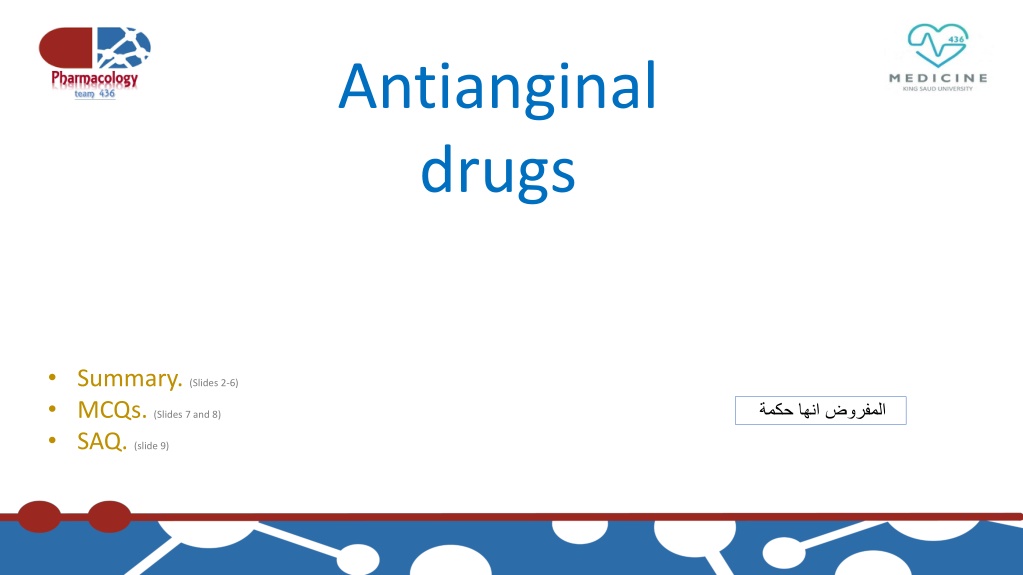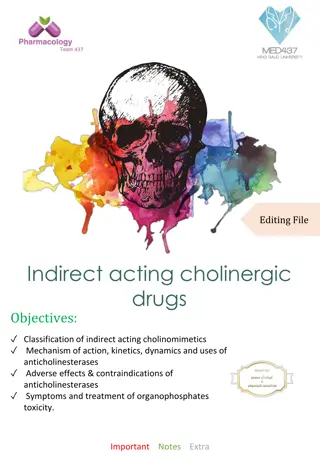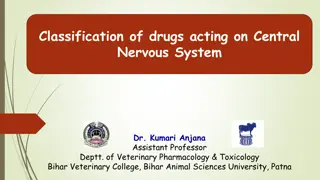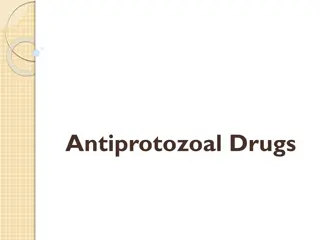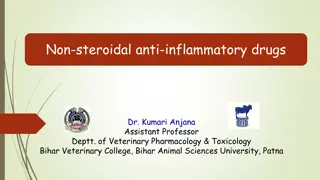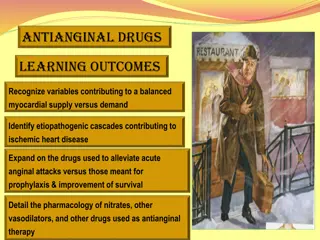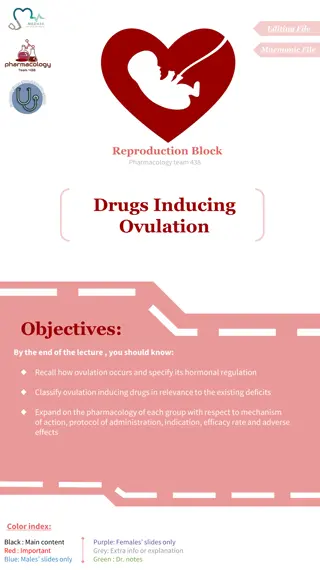Understanding Antianginal Drugs: Mechanisms, Classification, and Usage
Signs, symptoms, and types of angina pectoris are explored, along with the determinants of oxygen demand and supply. Treatment options, including organic nitrates like isosorbide mononitrate and nitroglycerine, are detailed, highlighting their mechanisms of action, hemodynamic effects, adverse reactions, and contraindications. The classification, pharmacokinetics, and indications of organic nitrates in managing stable and unstable angina are also discussed.
Download Presentation

Please find below an Image/Link to download the presentation.
The content on the website is provided AS IS for your information and personal use only. It may not be sold, licensed, or shared on other websites without obtaining consent from the author. Download presentation by click this link. If you encounter any issues during the download, it is possible that the publisher has removed the file from their server.
E N D
Presentation Transcript
Antianginal drugs Summary. (Slides 2-6) MCQs. (Slides 7 and 8) SAQ. (slide 9)
Signs and symptoms the mechanism of angina pectoris Types of angina pectoris: 1- chest pain (varying in severity) caused by ischemia of heart muscle 2- pain due to the accumulation of metabolites (K+,PGs, kinins, adenosine) secondary to ischemia 3-pain due to either obstruction or spasm Is a consequence of myocardial oxygen demand exceeding myocardial oxygen supply 1- stable angina 2- variant angina 3- Unstable angina What are the determinants of oxygen demand and oxygen supply ? Treatment of angina pectoris 1- symptoms and ischemia 2- Prognosis Aspirin / other antiplatelet agents ACE inhibitors Statins -blockers NBC Potassium channels openers. Late Na+ current inhibition :ranolazine. Sinus node inhibition. ex: Ivibradine. Agents that improve : 2
Organic nitrates Classification : long acting and short acting Nitric oxide binds to guanylate cyclase in vascular smooth muscle cell to form cGMP. cGMP activates PKG to produce relaxation. Mechanism of action Venous vasodilatation (Decrease the preload) at low dose Coronary vasodilatation (Increase the myocardial perfusion) Arterial vasodilatation (decrease afterload) at high dose Shunting (diverting) of flow from normal area to ischemic area by dilating collateral vessels Hemodynamic effects Throbbing headache - Flushing in blush area - Postural hypotension, dizziness & syncope - Tachycardia & palpitation - Rarely Met-hemoglobinema ADRs Known sensitivity to organic nitrates Glaucoma. nitrates increase synthesis of aqueous humor formation. Head trauma or cerebral haemorrhage = Increase intracranial pressure. Uncorrected hypovolemia Concomitant administration of PDE5 Inhibitors (phosphodiesterase type 5 inhibitor )(Slidenafil) Sildenafil + nitrates Severe hypotension & death contraindications Loss of vasodilator response of nitrates on use of long-acting preparations (oral, transdermal) or continuous intravenous infusions, for more than a few hours without interruption. tolerance 3
Organic nitrates Classification : long acting and short acting Long acting short acting Drug Isosorbide mononitate and dinitrate Nitroglycerine Isosorbide Dinitrate: Sublingual tablets - Oral sustained (extended) release Infusion Preparations Isosorbide mononitate: Mononitrate Oral sustained release Sublingual tablets spray - Transdermal patch - Oral or bucal - sustained release - I.V. Preparations Preparations Oral isosorbide Very well absorbed & 100% bioavailability The dinitrate undergoes denitration to two mononitrates both possess antianginal activity (both pharmacologically active) (t1/2 1-3 hours) Further denitrated metabolites conjugate to glucuronic acid in liver. Excreted in urine. Significant (high) first pass metabolism occurs in the liver (10-20%) bioavailability Given sublingual or via transdermal patch, or parenteral pharmacokinetics In stable angina: Acute symptom relief (sublingual) Situational prophylaxis IN VARIANT ANGINA (sublingual) IN UNSTABLE ANGINA (IV) Acute Heart Failure Refractory AHF and AMI (IV) In stable angina: Persistant prophylaxis Chronic Heart Failure Indications 4
Effects of nitrates in treatment of angina and their results Effects Results Arterial pressure O2 demand Ventricular volume O2 demand Diastolic perfusion time due to tachycardia myocardial perfusion Reflex tachycardia O2 demand Reflex in contractility O2 demand ) ( Collateral flow Improved perfusion to ischemic myocardium Left ventricular diastolic pressure Improve subendocardial perfusion Vasodilation of epicardial coronary arteries Relief of coronary artery spasm 5
class drugs mechanism Pharmacodynamics (Antianginal action) Therapeutic uses ADRs Cardiomyocyte Contraction cardiac work through their ve inotropic & chronotropic action (verapamil & diltiazem) myocardial oxygen demand VSMC Contraction Afterload cardiac work myocardial oxygen demand Coronary dilatation myocardial oxygen supply Binding of [CCBs] to the L-type Ca channels their frequency of opening. in response to depolarization entry of Ca Ca release from internal stores No Stimulus-Contraction Coupling RELAXATION IN VARIANT ANGINA : Attacks prevented (> 60%) / sometimes variably aborted IN UNSTABLE ANGINA: Seldom added in refractory cases Dihydropyridines Amlodepine Phenylalkylamines Benzthiazepines Ca+2 channel blockers As K channel opener : On vascular smooth muscles: opening K channels> hyperpolarization>vasodilation. On cardiomyocytes: opening K channels> repolarization> decrease cardiac work. As NO donor:Increase in cGMP/PKG which leads to vasodilation. has dual mechanism of action: 1. Opens potassium ATP channels (arteriolar dilator) 2. NO donor as it has a nitrate moiety (venular dilator) 1. 1.Prophylactic 2nd line therapy in stable angina 2.Refractory variant angina Flushing, headache, Hypotension, palpitation, weakness Mouth & peri-anal ulcers, nausea and vomiting. K+ CHANNEL blockers Nicorandil 2. Atenolol Bisoprolol Metoprolol (Selective 1) Decrease heart rate & contractility thus:-1Increase duration of diastole > increase coronary blood flow > increase oxygen supply 2-Decrease workload > Decrease O2 consumption > Decrease oxygen demand Stable , unstable angina and Myocardial infarction Adrenergic Blockers Oxygen requirement of glucose pathway is lower than FFA, during ischemia oxidized FFA levels rise, blunting the glucose pathway. Trimetazidine reduces oxygen demand without altering hemodynamics Trimetazidine GIT disturbances Inhibits late sodium current which increases during ischemia Prolongs QT intervals so contraindicated with class Ia and III antiarrhymatics Used in chronic angina concommitanly with other drugs Ranolazine dizziness , constipation Metabolically acting agents Used in treatment of chronic stable angina in Patients with normal sinus rhythm with - blockers Used in combination with beta blockers in people with heart failure with LVEF lower than 3 5 inadequately controlled by beta block whose heart rate exceeds 70/min reduces slope of depolarization, slowing HR, reducing myocardial work, and oxygen demand If current is an inward Na/K current that activates pacemaker cells of the SA node, ivabradine selectively blocks it Ivabradine luminous phenomena 6
MCQs 1- What is the clinical term for angina caused by coronary vasospasm? A. Classic angina. B. Myocardial infarction. C. Prinzmetal angina. D. Unstable angina. 2- All of the following medications can be useful for managing stable angina in a patient with coronary artery disease except: A. Amlodipine. B. Atenolol. C. Immediate-release nifedipine. D. Isosorbide dinitrate 3- A 72-year-old male presents to the primary care clinic complaining of chest tightness and pressure that is increasing in severity and frequency. his current medications include atenolol, lisinopril, and nitroglycerin. Which intervention is most appropriate at this time? A. Add amlodipine. B. initiate isosorbide mononitrate. C. initiate ranolazine. D. refer the patient to the nearest emergency room for evaluation 4- A 62-year-old patient with a history of asthma and vasospastic angina states that he gets chest pain both with exertion and at rest, about ten times per week. one sublingual nitroglycerin tablet always relieves his symptoms, but this medication gives him an awful headache every time he takes it. Which is the best option for improving his angina? A.Change to sublingual nitroglycerin spray. B. Add amlodipine. C. Add propranolol. D. Replace nitroglycerin with ranolazine. 5- Which side effect is associated with amlodipine? A. Bradycardia. B. Cough. C. Edema. D. QT prolongation. 6-C 5-C 6- Which medication should be prescribed to all anginal patients to treat an acute attack? A. Isosorbide dinitrate. B. Nitroglycerin patch. C. Nitroglycerin sublingual tablet or spray. D. Ranolazine 4-B 3-D 2-C 1-C 7
7- A 65-year-old male experiences uncontrolled angina attacks that limit his ability to do household chores. He is adherent to a maximized dose of B-blocker with a low heart rate and low blood pressure. He was unable to tolerate an increase in isosorbide mononitrate due to headache. Which is the most appropriate addition to his antianginal therapy? A. Amlodipine. B. Aspirin. C. Ranolazine. D. Verapamil. 8- A 68-year-old male with a history of angina had a MI last month, and an echocardiogram reveals heart failure with reduced ejection fraction. He was continued on his previous home medications (diltiazem, enalapril, and nitroglycerin), and atenolol was added at discharge. He has only had a few sporadic episodes of stable angina that are relieved with nitroglycerin or rest. What are eventual goals for optimizing this medication regimen? A. Add isosorbide mononitrate. B. Increase atenolol. C. Stop atenolol and increase diltiazem. D. Stop diltiazem and change atenolol to bisoprolol. 9- Which of the following medications would be safe to use in a patient taking ranolazine? A. Carbamazepine. B. Clarithromycin. C. Enalapril. D. Quetiapine. 10- A patient whose angina was previously well controlled with once-daily isosorbide mononitrate states that recently he has been taking isosorbide mononitrate twice a day to control angina symptoms that are occurring more frequently during early morning hours. Which of the following is the best option for this patient? A. Continue once-daily administration of isosorbide mononitrate but advise the patient to take this medication in the evening. B. Advise continuation of isosorbide mononitrate twice daily for full 24-hour coverage of anginal symptoms. C. Switch to isosorbide dinitrate, as this has a longer duration of action than the mononitrate. D. Switch to nitroglycerin patch for consistent drug delivery and advise him to wear the patch around the clock. 10-A 9-C 8-D 7-C 8
A 57-year-old patient with a history of hypertension over the last 5 years, diabetic sense he was 20 years old came to the ER with 8/10 substernal chest pain. While taking history the patients says that the pain comes with emotional stress and physical activity. the ER consultant called the cardiologist to help stabilizing the patient and to check up with him after being diagnosed with variant angina. Q1: What is the drug of choice to stabilize the patients in such scenario? Nitroglycerine Q2: What is the best root of administration of this drug? And why? Sublingual or parenteral due to its high first pass metabolism. Q3: are there any contraindicated group of drugs in this case? And why? Yes there is, beta blockers are contraindicated in patients with diabetes because beta blockers cover the signs of hypoglycemic state. Q4: What is the drug of choice in long term prophylactic therapy in this patient? K channels blockers 9
Editing file Revised by: Done by: Abdulrahman Thekry Ghadah Almuhana Shoag Alahmari Shrooq Alsomali Contact us : @Pharma436 Pharma436@outlook.com
